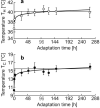Limits of temperature adaptation and thermopreferendum
- PMID: 33823918
- PMCID: PMC8025563
- DOI: 10.1186/s13578-021-00574-9
Limits of temperature adaptation and thermopreferendum
Abstract
Background: Managing the limits of temperature adaptation is relevant both in medicine and in biotechnology. There are numerous scattered publications on the identification of the temperature limits of existence for various organisms and using different methods. Dmitry Petrovich Kharakoz gave a general explanation for many of these experimental results. The hypothesis implied that each cycle of synaptic exocytosis includes reversible phase transitions of lipids of the presynaptic membrane due to the entry and subsequent removal of calcium ions from the synaptic terminal. The correspondence of the times of phase transitions has previously been experimentally shown on isolated lipids in vitro. In order to test the hypothesis of D.P. Kharakoz in vivo, we investigated the influence of the temperature of long-term acclimatization on the temperature of heat and cold shock, as well as on the kinetics of temperature adaptation in zebrafish. Testing the hypothesis included a comparison of our experimental results with the results of other authors obtained on various models from invertebrates to humans.
Results: The viability polygon for Danio rerio was determined by the minimum temperature of cold shock (about 6 °C), maximum temperature of heat shock (about 43 °C), and thermopreferendum temperature (about 27 °C). The ratio of the temperature range of cold shock to the temperature range of heat shock was about 1.3. These parameters obtained for Danio rerio describe with good accuracy those for the planarian Girardia tigrina, the ground squirrel Sermophilus undulatus, and for Homo sapiens.
Conclusions: The experimental values of the temperatures of cold shock and heat shock and the temperature of the thermal preferendum correspond to the temperatures of phase transitions of the lipid-protein composition of the synaptic membrane between the liquid and solid states. The viability range for zebrafish coincides with the temperature range, over which enzymes function effectively and also coincides with the viability polygons for the vast majority of organisms. The boundaries of the viability polygon are characteristic biological constants. The viability polygon of a particular organism is determined not only by the genome, but also by the physicochemical properties of lipids that make up the membrane structures of synaptic endings. The limits of temperature adaptation of any biological species are determined by the temperature range of the functioning of its nervous system.
Keywords: Adaptation; Cold shock; Heat shock; Lipids; Temperature; Thermopreferendum; Viability polygon.
Conflict of interest statement
Authors have no conflict of interests. This research did not receive any specific grant from funding agencies in the public, commercial, or not-for-profit sectors.
Figures






Similar articles
-
Planning Implications Related to Sterilization-Sensitive Science Investigations Associated with Mars Sample Return (MSR).Astrobiology. 2022 Jun;22(S1):S112-S164. doi: 10.1089/AST.2021.0113. Epub 2022 May 19. Astrobiology. 2022. PMID: 34904892
-
Adjusting the thermostat: the threshold induction temperature for the heat-shock response in intertidal mussels (genus Mytilus) changes as a function of thermal history.J Exp Biol. 2001 Oct;204(Pt 20):3571-9. doi: 10.1242/jeb.204.20.3571. J Exp Biol. 2001. PMID: 11707506
-
Trehalose synthesis is induced upon exposure of Escherichia coli to cold and is essential for viability at low temperatures.Proc Natl Acad Sci U S A. 2002 Jul 23;99(15):9727-32. doi: 10.1073/pnas.142314099. Epub 2002 Jul 8. Proc Natl Acad Sci U S A. 2002. PMID: 12105274 Free PMC article.
-
Cold shock response and adaptation at near-freezing temperature in microorganisms.Sci STKE. 2004 Jun 9;2004(237):pe26. doi: 10.1126/stke.2372004pe26. Sci STKE. 2004. PMID: 15199224 Review.
-
Cold shock injury in animal cells.Symp Soc Exp Biol. 1987;41:311-40. Symp Soc Exp Biol. 1987. PMID: 3332489 Review.
Cited by
-
High Capacity for Physiological Plasticity Occurs at a Slow Rate in Ectotherms.Ecol Lett. 2025 Jan;28(1):e70046. doi: 10.1111/ele.70046. Ecol Lett. 2025. PMID: 39829299 Free PMC article.
-
Environmental Temperature Variation Affects Brain Lipid Composition in Adult Zebrafish (Danio rerio).Int J Mol Sci. 2024 Sep 5;25(17):9629. doi: 10.3390/ijms25179629. Int J Mol Sci. 2024. PMID: 39273578 Free PMC article.
-
Effects of Environmental Temperature Variation on the Spatio-Temporal Shoaling Behaviour of Adult Zebrafish (Danio rerio): A Two- and Three-Dimensional Analysis.Animals (Basel). 2025 Jul 8;15(14):2006. doi: 10.3390/ani15142006. Animals (Basel). 2025. PMID: 40723469 Free PMC article.
References
-
- Kharakoz DP. Phase transition in lipids and the problem of homoiothermia. Biofizika. 2000;45(3):569–572. - PubMed
LinkOut - more resources
Full Text Sources
Other Literature Sources

